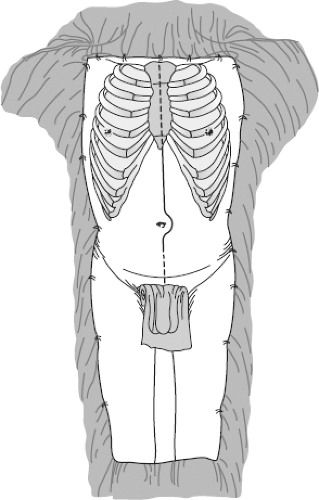Operating Room Practice
Steven A. Johnson
Michael Rhodes
I. Conducting Trauma Operation
The ideal location for a trauma operating room (OR) is adjacent or in close proximity to the trauma resuscitation unit. Ideally, it is always better to take the patient to the operating room as opposed to bringing the operating room to the patient. However, these principles are contingent upon hospital-specific geography, resources, and the scenario faced by the resuscitation team. Optimal situations dictate that the trauma operating room should be located in the main operating room suite to allow more flexibility of equipment and personnel. The so-called hybrid rooms with a diverse collection of equipment allow a multidisciplinary approach including full vascular/imaging and interventional technology. Elevator standby and priority transport protocols must be in place. All OR rooms should be stocked with the necessary tools to allow direct OR transport from the scene (in extremis) for continued resuscitation or procedural intervention. These scenarios may dictate bypass of the emergency department.
A trauma OR should have adequate space, 400 to 600 sq ft. Safety of the staff with properly configured ORs free of wires, equipment cords, and bulky items in walkways is a priority to avoid personnel injury. The following equipment and drugs should be available:
An OR table that is capable of radiography and fluoroscopy (i.e., Jackson table)
Warm intravenous fluids and blood products as appropriate (FFP, PRBCS, cryoprecipitate, platelets)
A rapid-infusion device
High quality OR lights that are adjustable and movable to allow adequate lighting during single or multiple, simultaneous OR procedures
Dedicated imaging equipment (built-in if possible) to move in and out of operative field
A minimum of four suction canisters
A minimum of eight electrical outlets
A blood salvage device (Cell Saver, thoracostomy auto-transfusion devices, etc.)
A multi-purpose anesthesia machine capable of high minute ventilation (up to 30 L/min.), increased levels of positive end-expiratory pressure (up to 20 cm H2O), and pressure support inverse-ratio ventilation. A dedicated respiratory therapist may be helpful in those patients with unconventional modes of ventilation such as APRV, high-frequency oscillator ventilation, and single lung ventilation. These modes are frequently utilized in the critically ill patient with severe ventilator-dependent respiratory failure/ARDS
Multichannel pressure monitoring
High resolution, high definition monitors for viewing radiologic images in the perioperative period
Patient external warmers/heating devices
Electrocautery with argon beam capability
Harmonic scalpel, handheld mesenteric ligation devices
Linear stapling devices
A general trauma tray with a Finochietto retractor, rib spreader, aortic compressor, sternal saw, Lebsche knife, Fogarty catheters, and a variety of vascular clamps
Head light (self-contained battery pack to allow ease of movement around table), face shields and/or goggles, boots, and impervious gowns for the operating team (UNIVERSAL PRECAUTIONS ARE ALWAYS MANDATORY)
II. ED TO OR and Operating Room (“Hand-Off”) Communication
The critically injured patient must be accompanied by the resuscitation team to the OR. Notification of the OR charge nurse should be done immediately upon patient arrival to clear the way for potential OR utilization. A point of care analyzer (INR, hemoglobin, and lactate parameters) is essential to continued resuscitation. Immediate and concise discussion between the operating surgeon, OR circulating/scrub teams, and most importantly, anesthesia personnel should ensue. This “hand-off” communication helps to ensure the availability of blood products and equipment. It also serves to outline key factors that relate to the patient’s medical history, mechanism of injury, and treatment(s) rendered in the ED. Patient safety initiatives using aviation crew resource management and TeamSTEPPS principles are recommended. Adequate lifting help must be on hand to move the patient from the stretcher and provide transfer of the patient to the OR table. All equipment such as pelvic binders or backboard equipment should be removed prior to the start of the case.
Stay updated, free articles. Join our Telegram channel

Full access? Get Clinical Tree








